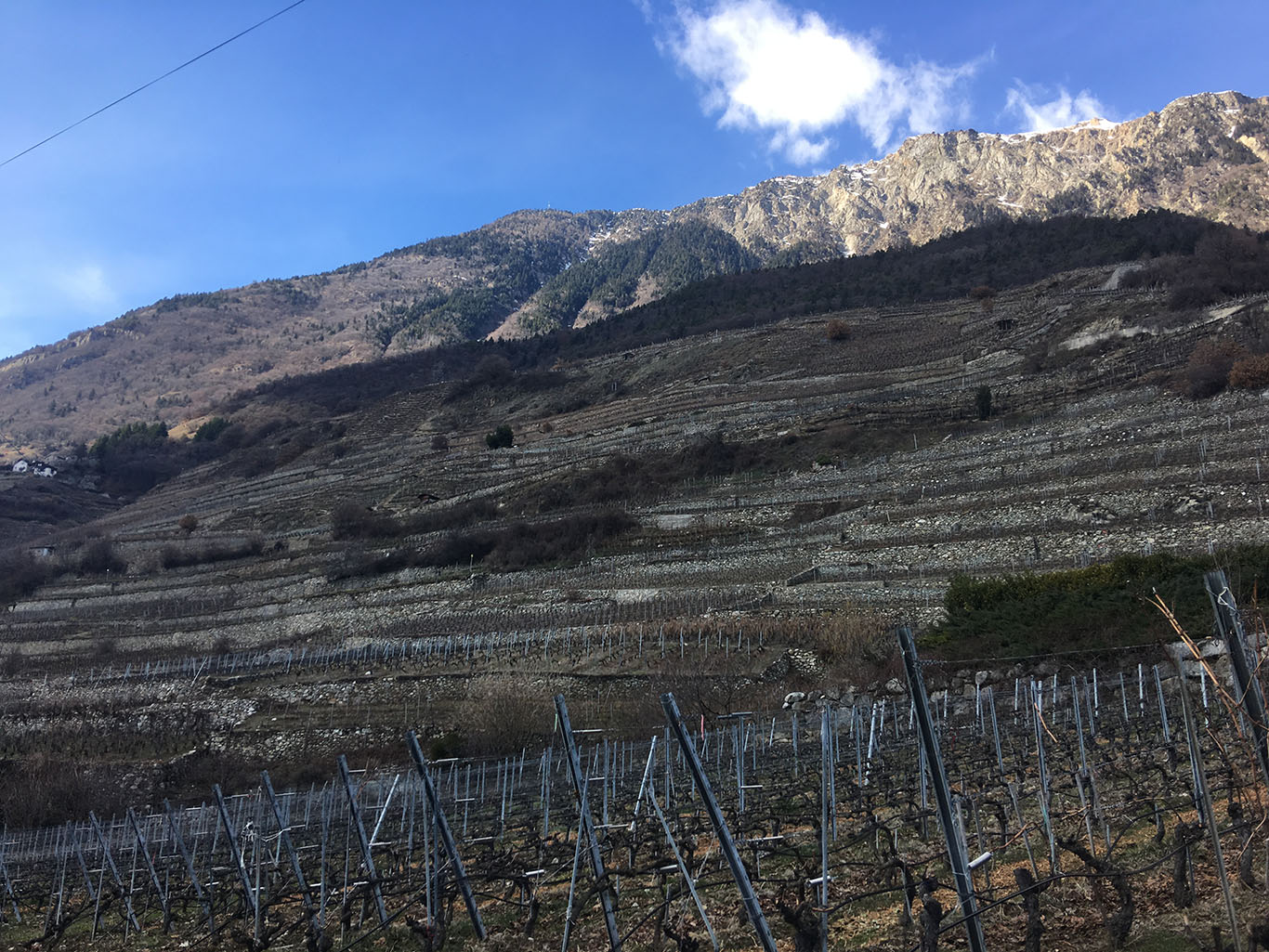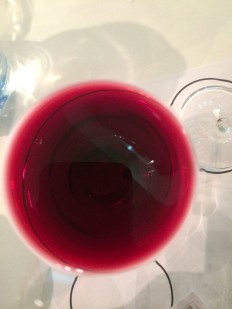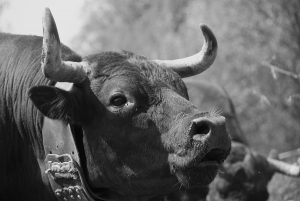
Tradition is a hot word in wine marketing right now, one that reassures consumers – and yet few of us who are on the buying end of the sales chain question what it means, I think.
If you have been making wine the same way for 50 years, does that make your wine traditional? 100 years? Or what if you’ve made changes to the way your grandfather did it – can you call yours a traditional wine?
I led a discussion of “tradition” Wednesday evening during a tasting session of four Swiss wines that helped us reflect on various understandings of the word. Here are some notes from the evening:

The four wines I selected for the wine club at L’école hotelière Les Roches in Bluche, Valais represent just four aspects of tradition in winemaking: traditional use of yeasts, a relatively recent but now-established tradition of blending reds in Valais, traditional grapes, wines made by generations of the same family in Lavaux. This is hardly a definitive look at traditions in the wine world, but if we’re trying to learn to question marketing-speak, these are a good starting point.
French vs English sense of tradition
Earlier this week I had two Swiss wine producers remind me, separately, that the sense of the word “tradition” is not quite the same in French as in English.
The word in English implies unchanged, or little changed. The Oxford Dictionary refers to “a long-established custom or belief that has been passed on from one generation to another” and other dictionaries provide similar definitions. Larousse, defining the word in French, appears to say something similar: “Manière d’agir ou de penser transmise depuis des générations à l’intérieur d’un groupe”. A way of doing something or of thinking that has been shared for generations – the difference is subtle but important in the world of wine because it begs the question of how much change is acceptable or desirable if you want to make wines that represent traditions.
The wines we tasted
The wines we tasted, in order (1 white, 2 reds, 1 white):
“R3” Räuschling 2016, AOC Zurich: 3 Zurich area wineries (joint project)
Dôle “La Liaudisaz” 2014, AOC Valais: Domaine Chappaz, Fully, Valais
(Along with a small sip of Dôle de Sierre 2015 from Maurice Zufferey, to compare)
Cornalin 2014, AOC Valais: Maurice Zufferey, Sierre, Valais
“Haut de Pierre” Dézaley AOC Grand Cru 2015: Blaise Duboux, Epesses, Vaud
For background, see Alexander Truffer’s recent article on tradition: the original in French, my translation in English.
Are old yeasts better?

“R3”, a Räuschling wine from the greater Zurich area, is special for a number of reasons. German-speaking Switzerland, with Zurich as the hub, produced more wine than the French-speaking areas until the 1870s.
Today, with pressure from urban populations and industry, the area devoted to vineyards has shrunk significantly and all of German-speaking Switzerland produces less than either cantons Valais or Vaud.
Räuschling was probably over-produced at one point, with too many mediocre wines made from the grape, and the wine that was synonymous with Zurich fell out of favour.
 It is a crisp white with citrus notes and good acidity, perfect with fish and wonderful when made well.
It is a crisp white with citrus notes and good acidity, perfect with fish and wonderful when made well.
Three well-respected wineries in the area decided in 2008 to make a Räuschling that would represent the best of this grape, which was long thought (wrongly, notes scientist José Vouillamoz in the reference book Wine Grapes) to be related to Riesling or the very old Swiss-German grape Completer. “R3” combines grapes from different terroirs in the region, all of notably good quality.
“R3” is also one of the first grapes made with a yeast known as W1895, which has an extraordinary, Swiss history. Yeast, through the process of fermentation, makes wine possible: when oxygen is not present yeast converts, or transforms, wine grapes’ sugars into alcohol and carbon dioxide. People obviously knew about using yeast for centuries – to make bread, to make wine and beer – but it was in the period from 1850-1880 that scientists began to realize that yeast is a living microbe and to understand how it works. I won’t get into the scientific history of yeast here, but enormous strides have been made in developing strains of yeast that have helped the wine industry improve quality and solve technical problems.
 In 2008 Zurich wine producer Stickel Schwarzenbach and Jürg Gafner, a scientist at the Research Institute in Wädenswil, sat down with a small group to do a vertical tasting of some very, very old wines, part of a group of 80 bottles that were still good, from 1895-1917, found by an old Meilen winemaker when he cleared out his cellar. Hermann Schwarzenbach, Stickel’s father, had recorked the old wines shortly after they were found. The group doing a final tasting, in 2008, wanted to see if any of the yeasts in these wines were still alive. The answer: yes, six strains from three vintages were indeed alive. One from the oldest bottle, an 1895 Räuschling, has been commercialized successfully because of particular qualities it offers (an example: helping wines with “stuck fermentation”). Today it’s referred to as the Sleeping Beauty Yeast.
In 2008 Zurich wine producer Stickel Schwarzenbach and Jürg Gafner, a scientist at the Research Institute in Wädenswil, sat down with a small group to do a vertical tasting of some very, very old wines, part of a group of 80 bottles that were still good, from 1895-1917, found by an old Meilen winemaker when he cleared out his cellar. Hermann Schwarzenbach, Stickel’s father, had recorked the old wines shortly after they were found. The group doing a final tasting, in 2008, wanted to see if any of the yeasts in these wines were still alive. The answer: yes, six strains from three vintages were indeed alive. One from the oldest bottle, an 1895 Räuschling, has been commercialized successfully because of particular qualities it offers (an example: helping wines with “stuck fermentation”). Today it’s referred to as the Sleeping Beauty Yeast.
“In modern winemaking, fermentations are driven largely by single-strain inoculations; pure cultures of selected strains of S. cerevisiae are added to grape must as soon as possible after crushing. This ensures greater control of vinification, leads to more predictable outcomes and decreases the risk of spoilage by other microorganisms. There are many—probably hundreds of—different yeast strains available, and the winemaker’s choice can substantially effect the quality of the wine” – From a technical article on the history of yeast in winemaking published by the US National Library of Medicine.
Despite all the progress made with new strains of yeast, aided by new technology and DNA studies, it was still possible to find something of great interest today in a very old bottle of wine, from a time when yeasts used were mainly those found in a winemaker’s cellar. The wineries involved in creating “R3” use this 1895 yeast to show it is capable even today of helping make a high-quality Räuschling wine. Is this wine identical to the 1895 bottle they drank, when it was young? Undoubtedly not, for yeast is only one factor in making a wine what it is, but it could well be a close kin to the 1895 vintage in its youth.
Natural wines today use indigenous yeasts, those found naturally in the fermentation cellar, and proponents of using only these yeasts will argue these wines are better, and that their use is “traditional”, but in fact it is only technical progress made in this century that has allowed them to make reliably good wines using these wild yeasts.
For more on the tasting session where the live 1895 yeast was found, and its implications: Memoire des vins suisses (French, German).
Valais Dôle, a reflection of pragmatism

The Dôle produced today by Marie-Thérèse Chappaz is a fine example of a wine that has maintained its popularity despite changing shape and style for more than a century. It has always been a pragmatic wine, designed to give growers a bit more flexibility and consumers an affordable and decent table wine.

A grape variety called Dôle, from the Jura region, arrived in Valais in 1850, and was blended, from the outset, with Gamay grapes. The name gradually came to mean Pinot Noir, then a blend of that grape with Gamay, and then as people started to call Pinot Noir wines after the grape Dôle came to mean a blend of it – often with more Gamay than Pinot. But the name and what grapes were behind it varied from place to place. Marie-Thérèse tells me that in Fully, where she produces her wine, more Gamay was always used than in Sierre, where more Pinot Noir is planted.
For comparison, we tasted hers and a bit of Sierre Dôle from Maurice Zufferey, which indeed has more Pinot: the Fully wine was fruitier and darker, the Sierre one more austere, with the upright lightness of good Pinot, although Maurice’s does have 5% Gamaret as well as 85% Pinot Noir and 10% Gamay.
Traditionally, the blend made a light and popular wine, and it was one of the earliest efforts to produce a blended wine that was similar throughout the region. Producers could vary it from year to year depending on their harvests. But the rush in the 1950s to grow more and more grapes, with help from the new chemical fertilisers, herbicides and insecticides, led to a glut and lower quality wines.

By the end of that decade the canton put in place regulations that required higher sugar levels for Dôle wines; lesser quality grapes went into a wine called Goron. Dôle became an AOC from Valais with 85% Pinot Noir and Gamay the dominant but not necessarily sole other wine in the blend.
Dôle remains very popular in the canton despite its shifting nature over the past 167 years, a Valais economic and cultural tradition that has left room for flexibility from one area to another, one vintage to another.
Cornavin and traditional grapes

Native grapes, many of them produced in relatively limited quantities are the pride of canton Valais today, as they are, increasingly, in other places. The Wine Mosaic non-profit organization in France, for example, is fighting to preserve older, indigenous grape varieties, noting that only 30 major grapes produce 70% of the world’s wine.
The project is based around two fundamental ideas:
Production: highlight original varieties. Develop practical measures to ensure their preservation, and increase the production of quality wines made from these varieties
Consumption: raise the awareness and consumption of wines made from original grape varieties.
and strives to “help [producers] find the necessary tools and assistance to make, sell and promote wines made from endangered, indigenous and historic or traditional grape varieties.”

Cornalin is one of the star grapes in the Valais lineup of native grapes, which includes Humagne Rouge, another red, and the very special white grapes, Petite Arvine and Amigne. Cornavin has been mentioned in historical documents since the middle of the 14th century, yet it came close to extinction – hard to believe when you taste the beautiful wine that can be made from it.
Maurice’s uncle was an ardent fan of Cornalin who insisted that the grape be saved despite its reputation for being difficult to grow: inconsistent harvests (one year good, the next small), sensitive to weather conditions and in need of good sun exposition. Maurice in his turn and a small group of growers have fought to preserve the grape by refining cultivation methods so it is commercially viable.
While we found some of the cloves and black cherries one expects in this traditional wine, the 2014 was perhaps less aromatic than some of the Cornalins I’ve had from Maurice and other good producers (Mercier Vins in Sierre, André Fontannaz at Cave de la Madeleine in Vétroz, and Domaine Cornulus in Savièse are among my favourites). Not surprising: these are terroir wines that reflect each vintage’s strengths and weaknesses.
15 generations, each its own wines

Lavaux at first appears to be a place where change comes slowly if ever – but appearances can deceive. Blaise Duboux represents the 15th generation in Epesses. His family has tended the same vines since the 15th century, with Chasselas as a main grape. Blaise is known in Switzerland but also abroad for his Chasselas, with a line of different terroir wines.
I asked him about the burden of knowing it is up to you to carry on doing what your family has always done.
“It hurts when I have to take out old vines,” he mused. “Knowing they were planted by someone who was there before me …” and what those ancestors were trying to do, when it was their turn to be the vineyards’ caretaker.
But he’s quick to point out that while each generation carries the weight of family history, it’s also a matter of individuals doing a job. “To keep the traditions you want, that are important, you have to adapt, have to adjust.”
Case in point: his father was the first generation to learn winemaking at a post-secondary school, not simply from his own father. He came into the vines in the 1960s, a time when growers were trying to boost harvests with all the new chemical treatments that had just appeared, long before anyone realized there was a down side to this.
Blaise, 50 years on, is headed in another direction with his vines and has been actively pushing for Lavaux to become organic. “It’s taken us decades to get rid of the effects [of the treatments, in the soil]. So while Lavaux and Unesco celebrate the Lake Geneva hillside’s millennia of winemaking and wines with a long history like Blaise’s famous Dézaley Chasselas, growing methods and winemaking techniques have moved with the times.
Marie-Thérèse Chappaz, back in canton Valais, worries over those terms, “adjust” and “adapt”, saying that we must be very careful to give credit to older methods and the common sense and experience behind them – that adapting to new needs shouldn’t necessarily give us the right to change old traditions. The types of buildings or fermentation vats used in the past might not always look as splendid as some contemporary structures, but there was often a logic behind them that had an impact on, for example, the way fermentation occurred, or the behaviour of wine yeasts.

Maybe it’s easier to understand, she says, if we look at cheese. She points to traditional cheeses such as Roquefort in France or Switzerland’s Etivaz, the first produced in caves, the second made from milk that comes from cows whose only food is Alpine pastures.
Both have very strict AOP (designation of origin) regulations; from the Swiss AOP office (my italics):
Designation of origin (Art. 2)
As designation of origin (PDO) the name of a region or a place can be registered which serves to designate an agricultural product or a processed agricultural product which:
comes from the corresponding area or the corresponding place;
which owes its quality or its characteristics mainly or exclusively to the geographic conditions with the inherent natural and human influence;
which was produced, processed and prepared in a determined geographical area.
For Marie-Thérèse, without stringent AOP rules it would be too easy to keep only part of the traditions that have created special agricultural products – a Roquefort “that would be like plastic!”, not made in caves. An Etivaz from milk that isn’t from summer pastures, that would lose its magical hints of fruits and hazelnuts. The same is true for wine.
Traditions need to be carefully safeguarded, she argues. First, of course, we need to know and understand them. So the next time someone tells you his wine is “traditional”, try to find out why and how.
Leave a Reply
You must be logged in to post a comment.